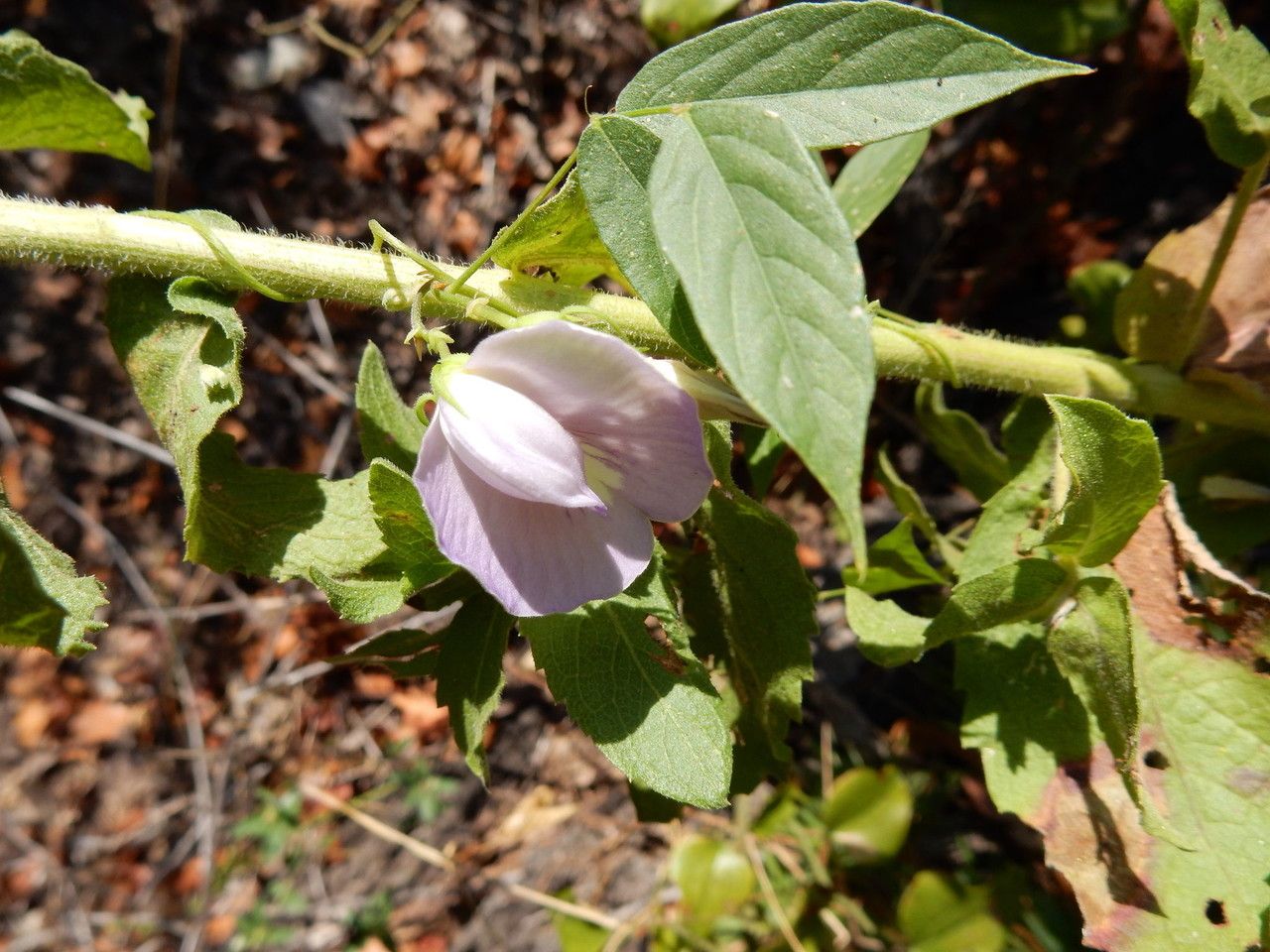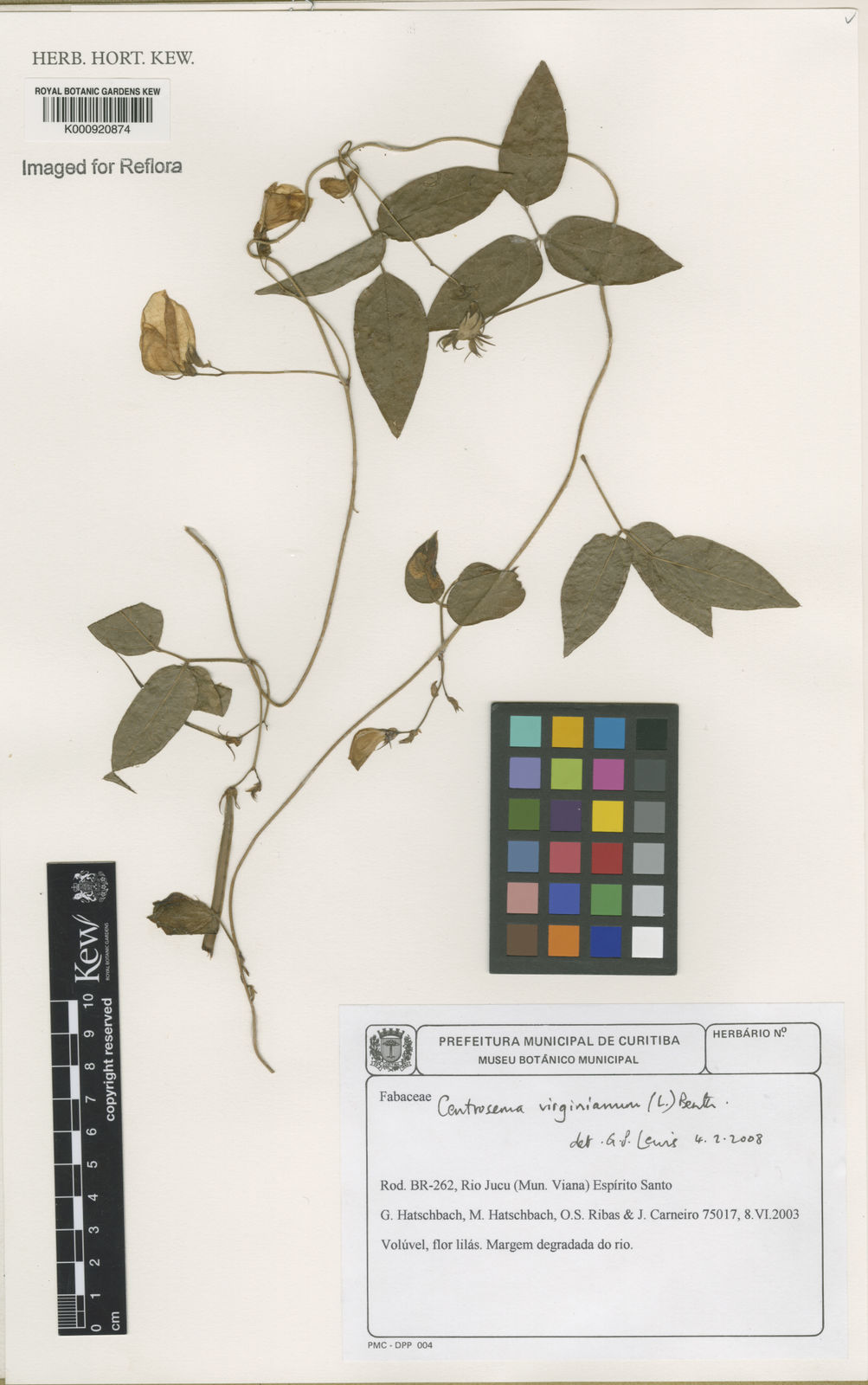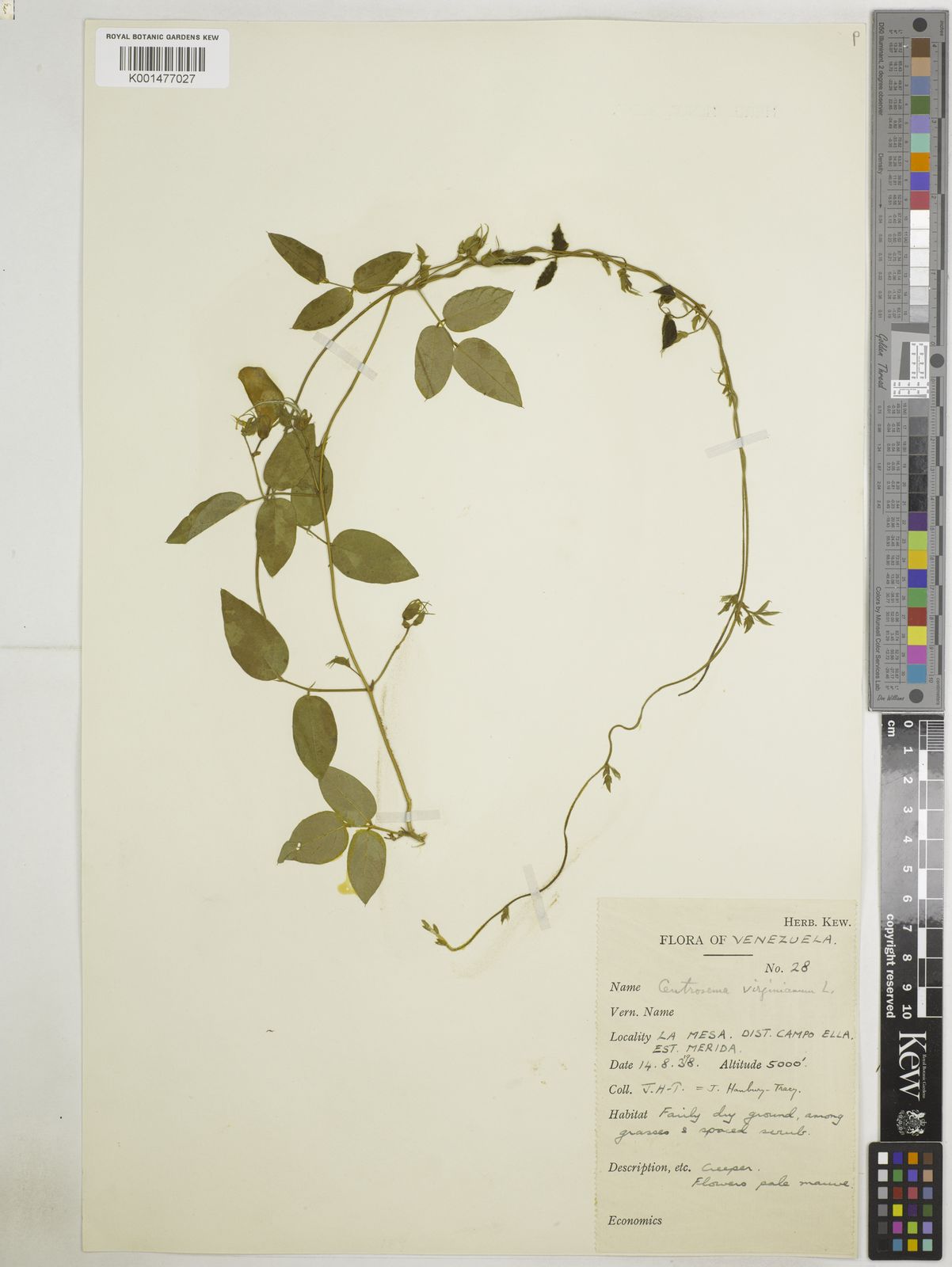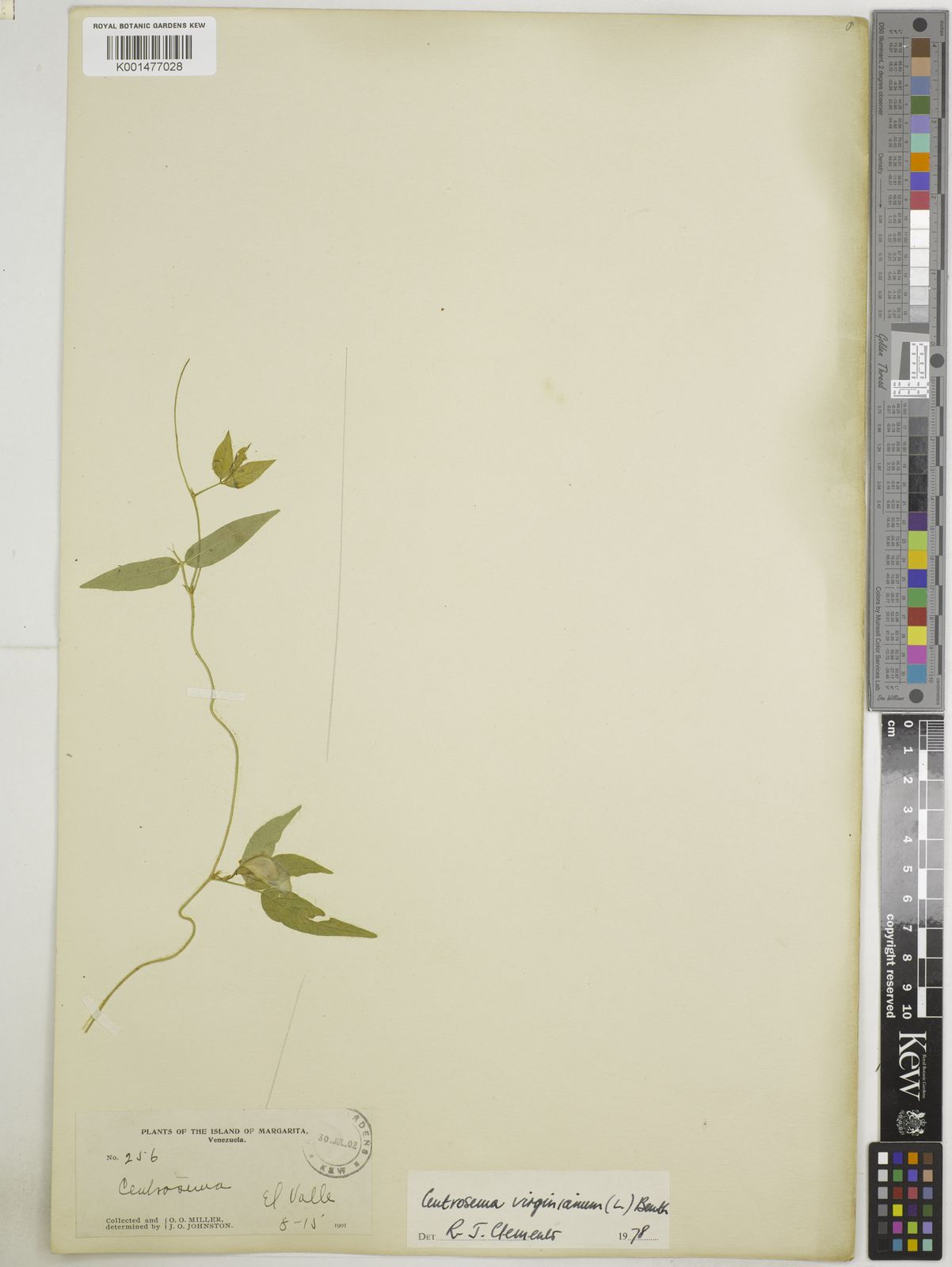Virginia butterfly pea
centrosema virginianum
Also known as: ["Butterfly pea vine","Southern butterfly pea"]
Overview
A twining vine with showy, pea-like flowers that attract pollinators, native to the southeastern United States.
Benefits & Perks
["long-flowering","wildlife attractant (bees, butterflies, birds)","drought tolerant"]
Botanical Classification
| Phylum: | Magnoliophyta |
| Class: | Magnoliopsida |
| Order: | Fabales |
| Family: | Fabaceae |
| Genus: | Centrosema |
| Botanical Name: | Centrosema virginianum |
Plant Characteristics
Basic Information
- Category: Flowers
- Suitable Location: garden bed or container in a partially shaded area
- Suitable For:
- Is Weed: No
- Allergenicity: low
Environmental Needs
- Climate: {"temperatureRange":"10–35°C"}
- Hardiness: {"zones":"8–11"}
- Misting: rarely required, only if ambient humidity is very low
- Drainage: Fast-draining to prevent waterlogging.
- Soil Type: Well-draining, loamy soil with organic matter; can tolerate sandy soils.
Maintenance Level
- Maintenance Level: moderate
- Toughness Level: moderate
- Pruning Frequency: As needed, typically every 2–3 months or after flowering.
- Pruning Intensity: Moderate; remove up to one-third of growth if necessary to rejuvenate the plant.
Care Details
Ideal Sunlight Coverage:
Bright indirect light for 6–8 hours daily; tolerates partial shade, especially in hot climates.
Sunlight Tolerance Tips:
Acclimate gradually to intense sunlight; protect from harsh afternoon sun; adjust placement based on indoor/outdoor conditions.
Care Requirements
Care Difficulty
moderatemoderate
Sunlight
partial shade to full sun
Rotate plant for even growth; use sheer curtains to filter direct sun; avoid dark corners.
Watering
every 7–10 days during active growth, reduce in winter
Water thoroughly but infrequently; ensure soil dries slightly between waterings; avoid overwatering.
Soil
well-draining, loamy soil with moderate organic matter
pH: Slightly acidic to neutral (pH 6.0–7.0).
Use a mix of potting soil, perlite, and compost; avoid heavy clay soils; ensure pots have drainage holes.
Temperature
Prefers warm temperatures (65–85°F); sensitive to frost; thrives in tropical to subtropical climates.
Avoid sudden temperature changes; protect from drafts; maintain consistent warmth during active growth.
Fertilizing
every 4–6 weeks during growing season
Apply fertilizer after watering to prevent root burn; flush soil occasionally to prevent salt buildup; reduce feeding in dormancy.
Propagation
Methods
Stem cuttings or division; stem cuttings are more common for home growers.
Step-by-Step Propagation Guide
- Take a healthy cutting.
- Remove lower leaves.
- Apply rooting hormone (optional).
- Plant in medium.
- Keep moist and warm.
Best Time: Spring or early summer when the plant is actively growing.
Environment
Warm, humid environment with indirect light; maintain consistent moisture.
Medium
Well-draining potting mix with perlite or sand; can also root in water initially.
Hormone
Rooting hormone can be used but is not strictly necessary.
Timeline
Roots may develop in 2–4 weeks; new growth may appear in 6–8 weeks.
Tools Needed
Pruning shears, rooting hormone (optional), small pots, well-draining medium.
Quick Tips
Use healthy, non-flowering stems; keep cuttings out of direct sun; maintain humidity with a plastic bag if needed.
Pruning & Repotting
Pruning Guide
Method
Pinch back tips for bushier growth; cut stems just above a leaf node or bud.
Pruning Plan
Prune to maintain shape, encourage bushier growth, and remove dead or overgrown stems.
Tools
Clean, sharp pruning shears or scissors.
Checklist
Sanitize tools; prune dead or damaged growth; shape as desired; dispose of clippings.
Repotting Guide
Best Season
Spring, before the active growing season begins.
Pot Size
Increase pot size by 1–2 inches in diameter; avoid oversized pots.
Method
Remove plant gently; trim roots if crowded; place in a slightly larger pot with fresh soil; water lightly.
Suggestions
Repot every 2–3 years or when roots fill the pot; beneficial for growth and health.
Checklist
Check root bound status; prepare new pot with drainage; trim roots if needed; use fresh soil.
Advanced Care Tips
Watering Mastery
Watering Checklist
Check soil moisture; water deeply; ensure drainage; adjust for season.
How to Apply Water Properly
Water at the base of the plant, ensuring moisture reaches the root zone; allow excess water to drain away; water in the morning to reduce evaporation.
Watering Schedule Tips
Water deeply once the top inch of soil feels dry; reduce frequency in winter to prevent root rot.
Soil Improvement
Add perlite or sand for drainage; incorporate compost for fertility; ensure good aeration.
Temperature Stress Management
Signs of Temperature Issues
Wilting, yellowing leaves, or stunted growth in cold; leaf scorch or bud drop in excessive heat.
Cold Stress
Growth slows or halts; leaves may turn yellow or brown; risk of frost damage or death in freezing temperatures.
Solution: Move to a warmer location; provide frost protection; avoid cold drafts; reduce watering in cool conditions.
Hot Stress
Leaves may wilt, curl, or scorch; growth may slow; increased water demand.
Solution: Provide shade during peak heat; increase watering frequency; ensure good air circulation.
Fertilizing Guide
Fertilizing Checklist
Check season; dilute fertilizer; apply to moist soil; avoid contact with foliage.
Fertilizing Method
Use balanced liquid fertilizer diluted to half strength every 4–6 weeks during growing season; avoid fertilizing in winter.
Common Problems & Solutions
Toxicity Warning
Cats
Non-toxicCentrosema virginianum is not considered toxic to cats. There are no documented cases of toxicity in felines from exposure to this plant.
⚡ Toxic If:
Generally non-toxic
Dogs
Non-toxicCentrosema virginianum is not considered toxic to dogs. There are no documented cases of toxicity in canines from exposure to this plant.
⚡ Toxic If:
Generally non-toxic
Humans
Non-toxicCentrosema virginianum is not considered toxic to humans under normal circumstances. It has no known adverse effects when handled or ingested in typical amounts.
⚡ Toxic If:
Generally non-toxic
Frequently Asked Questions
Q: Does this plant require support to grow?
A: Yes, it is a twining vine that benefits from a trellis or support structure.
Q: Is it suitable for container gardening?
A: It can be grown in large containers with support, but it prefers open ground.
Q: How often should it be watered?
A: Water moderately, allowing the soil to dry slightly between waterings; more frequent watering may be needed during drought.
Quick Reference
| Family: | Fabaceae |
| Care: | moderate |
| Light: | partial shade to full sun |
| Water: | every 7–10 days during activ |
Get Expert Care Tips
Download the Plantious app for personalized care reminders and plant identification!
Google Play App Store








